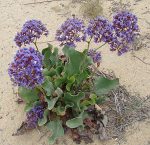
Also called western marsh rosemary, this mounding evergreen herb or subshrub is a member of the leadwort family, Plumbaginaceae, that also includes thrift. It is native to western US from Oregon to California where it grows in coastal habitats such as salt marshes, prairies, and dunes. Plants grow from a rhizomatous fibrous root system and have a woody caudex that produces a basal rosette of oval, thick leathery leaves up to 12″ long and with sunken salt glands on their underside. From summer to fall terminal clusters of flowers appear on stiff branched panicles up to 14″ long. Each flower has 5 white to pale lavender petals and 5 brownish white ribbed sepals. California sea lavender is appropriate for ponds and bog gardens. The genus name, Limonium, comes from the Greek word leimon, meaning meadow, and refers to the common habitat of the genus in saltmeadows. The specific epithet, californica, refers to the geographic location of the plant.
Type: Evergreen herbaceous perennial or subshrub
Bloom: Terminal clusters of white to pale lavender petals from summer into fall
Size: 2′ H 2′ W
Light: Full sun
Soil: Average, medium moist to wet
Hardiness: Zones 8-10
Care: Low maintenance
Pests and Diseases: None of significance
Propagation: Seed, division
Companion Plants: Broadleaf cattail, gumplant, fleshy jaumea